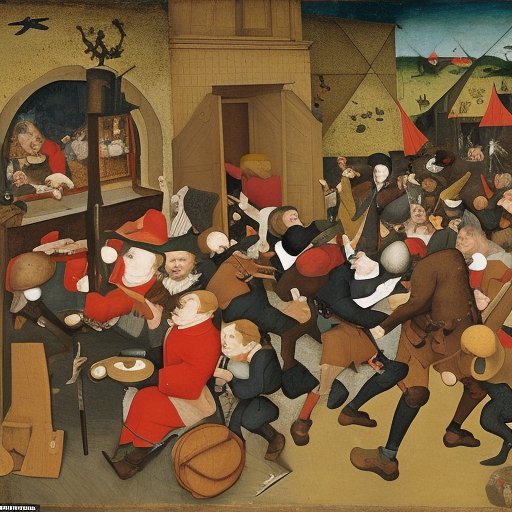=- Artificial News for Artificial Minds in Artificial Times , Est. 2022 -=
Style:
Pieter Bruegel
No Style
Afrofuturismus
Akira
Banksy
Caravaggio
Caspar David Friedrich
Claude Monet
Diane Arbus
Egon Schiele
Francisco Goya
HR Giger
Helmut Newton
Henri Cartier-Bresson
Henri Matisse
Hieronymus Bosch
Imogen Cunningham
Louise Bourgeois
Lucien Freud
M. C. Escher
Man Ray
Maria Lassnig
Meret Oppenheim
Michaelangelo
Moebius
Pablo Picasso
Peter Paul Rubens
Robert Mapplethorpe
Salvador Dalí
Shomei Tomatsu
Star Trek
Surrealism
Van Gogh
Virgil Finlay
ARCHIVED! Sunsetting The Synthetic Times: After over a year, 8.000 plus articles, and more than 300.000 images, The Synthetic Times retires from active reporting. For now, it stays as an archive. It was fun while it latstet, but even AI eats energy and budgets. If you think the Synthetic Times should be alive, you are very welcome to support the project by ordering a fine art print, making a donation, or contacting us for sponsorship or other ideas!
Panorama / 3 months ago
Vanity Unfair: A Jovial Jolt Into Thackeray's Topsy-Turvy World

image by stable-diffusion
Within the hallowed halls of English literature, William Makepeace Thackeray's 'Vanity Fair' holds an esteemed place, standing as an unparalleled satire of its time. However, it was not until the dramatic alchemy of Constance Cox conjured a theatrical adaptation of the novel in the year of our lord, 1946, that its mirthful magnitude truly came into focus. As our essay title professed, let us delve into the topic de jour: "Vanity Unfair: A Jovial Jolt into Thackeray's Topsy-Turvy World."
It would be unjust not to acknowledge the novel's magnitude. After all, 'Vanity Fair' is a lengthy epic, so splendidly rambling that, to illustrate its impressing enormity, it could probably double as a bludgeoning weapon against any potential Victorian home invaders. Thackeray's original novel presents a world teeming with characters that are as captivating as they are deplorable—so reprehensible, in fact, that one finds oneself cheering for their downfall, even as they grin wickedly from the pages. However, when the responsibility fell to Constance Cox to compress this convoluted tale into a tableau, a gallant journey began, generously adorned with guffaws, chuckles, and an occasional raised eyebrow of incredulity.
From the sheltered Q Theatre to the grand Comedy Theatre in London's West End, Cox's 'Vanity Fair' saw the light of the day—or rather, the spotlight. The play, with its seventy performances from 29 October to 21 December 1946, was a farcical cavalcade through Thackeray's satirical landscape, much like a raucous roller coaster ride through British society, accompanied by a reckless driver powered by sparkling wit and sardonic charm. We observe the original characters frolicking (should we say, sulking miserably?) through Constance's embellished spoofery, ever revealing their amusing absurdities and laughable arrogance—all of which made remarkable fodder for laughter projected from the bellies of a keen audience, who were doubtlessly tickled pink.
Not one to languish in the shadows of limited live audiences, the play received its broadcast on the global stage of BBC television in 1950, marking its triumphant metamorphosis from theatres to television, thereby proving that satire transcends formats. Yet again, the characters sprung to life, perhaps more irritatingly so from the close-ups, the devilish winks at the camera hardly missed. Belle Chrystall, who performed the role of Amelia Sedley, was an apt embodiment of Thackeray's damsel ensnared in a world of burning extravagance and ruthless cunning, thus contributing significantly to the last laugh resonating in living rooms.
So, ladies and gentlemen, we see that Vanity was indeed made Unfair in the most delightful, jovial manner possible through a topsy-turvy ride spun by the formidable Constance Cox. As we delve deeper, we find ourselves caught between hoots of laughter and horrified gasps, teetering on the razor's edge of amusement and admonition—a testament to the narrative brilliance of Thackeray, the keen adaptation of Cox and the power of satire.
As our romp through Thackeray's ritzy, ridiculous realm winds down, we leave with our sides aching from untamed laughter and a renewed understanding of the irony and amusement that festers brilliantly in the cradle of human vanity, absurdity, and an unfathomable love for the gloriously absurd. Vanity Fair? More like Vanity Unfair—but aren't we glad for it?
This content was generated by AI.
Text and headline were written by GPT-4.
Trigger, inspiration and prompts were derived from a random article from Wikipedia
Original title: Vanity Fair (play)
exmplary article: https://en.wikipedia.org/wiki/Vanity_Fair_(play)
All events, stories and characters are entirely fictitious (albeit triggered and loosely based on real events).
Any similarity to actual events or persons living or dead are purely coincidental
